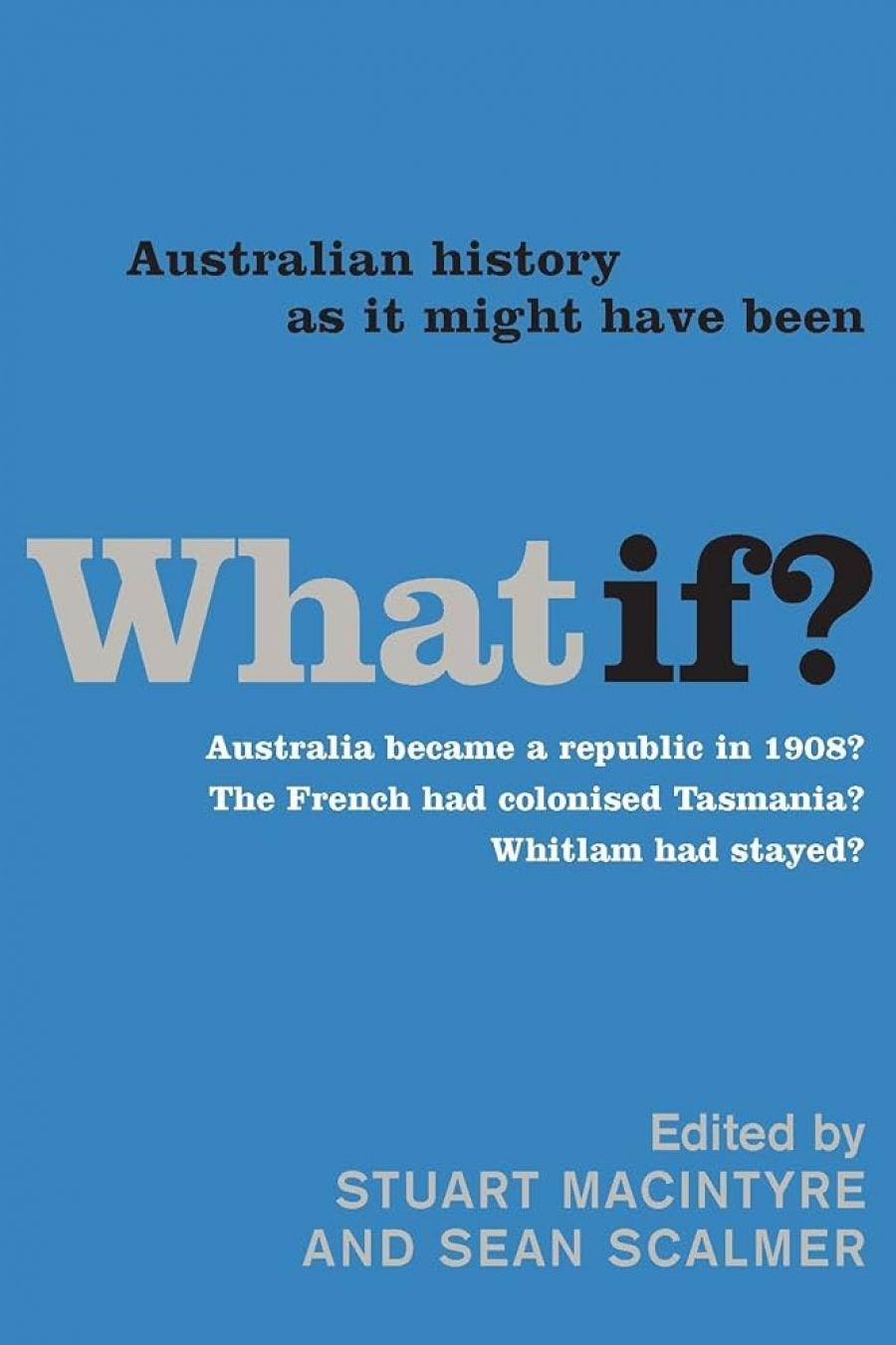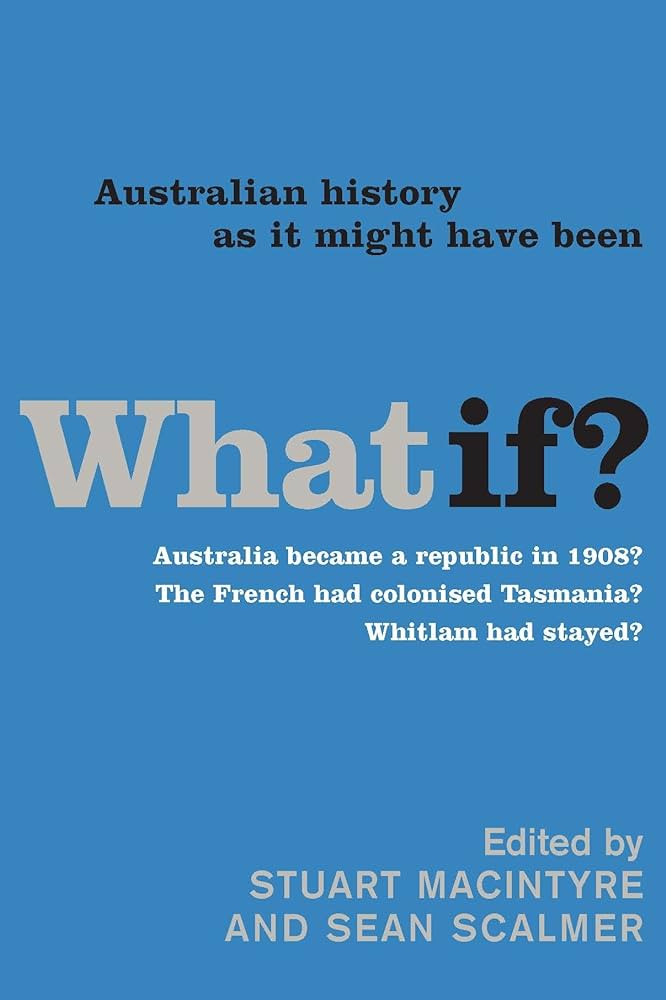
- Free Article: No
- Contents Category: Australian History
- Review Article: Yes
- Article Title: Parasitic on the actual
- Online Only: No
- Custom Highlight Text:
Thirteen scholars here have fun changing the course of Australian history, but this diverting exercise has the serious purpose of making the real history fresher, more complex and surprising.
Even the more implausible scenarios can have this effect. Marilyn Lake imagines Prime Minister Alfred Deakin declaring independence from Britain in 1908 and aligning Australia with the United States, which brings to our attention the high place in the Australian imagination accorded to the American republic as exemplar, potential ally and partner in the spreading of a vigorous white manhood across the new world. Ann Curthoys ponders the character and influence of feminism by imagining a men’s movement emerging in the 1970s.
- Book 1 Title: What If?
- Book 1 Subtitle: Australian history as it might have been
- Book 1 Biblio: MUP, $34.95 pb, 293 pp
- Book 1 Cover Small (400 x 600):

- Book 1 Cover (800 x 1200):

Virginia Spate supposes that a French artist from the school of Jacques-Louis David arrived in Sydney via Baudin’s expedition and established a school of figure painting. Then colonial painting, instead of being devoted to landscape, would have been attempting as well to render in human form the Australian variant of liberty, equality and fraternity. Imagine Australia Conferring Her Benefits Equally on All Her Children being the masterpiece at the Sydney International Exhibition of 1879. Much more plausibly, Jim Davidson envisages Van Diemen’s Land falling to the French, and composes a whole history for Tasmanie, which ends with Prime Minister John Howard ordering an invasion.
A recurring theme of the book is the positing of a different Labor Party and a different and more influential role for it. The style of the Labor Party was set in New South Wales after its amazing début in 1891, when it won a quarter of the seats. This was only possible because, two years before, payment of members had been introduced. Take that away, says Frank Bongiorno, and what happens? A much smaller Labor Party and a labour movement more diverse and less wedded to politics; a slower growth for the national party, so that Labor would not have been in office in World War I to destroy itself. If Federation had been delayed for ten years, supposes Helen Irving, then the Labor Party, definitely, and the women’s movement, perhaps, would have had a greater say in the framing of the constitution. Stuart Macintyre keeps the Labor Party in office during World War I, but changes the war. What if nearly all the troop ships carrying the first contingent of the AIF had been sunk by German raiders in the Indian Ocean? Australia’s contribution to Gallipoli would have been reduced, and there would have been greater cogency to the argument that Australia had to conserve its forces to meet dangers at home. This would have played to Labor’s strengths and kept it in office.
Labor’s history in modern times could have been very different with two minor adjustments. If Arthur Calwell had been killed by his would-be assassin during the 1966 election campaign, as Sean Scalmer proposes, Labor would still have lost, but narrowly, and Gough Whitlam would have won in 1969. Most plausible of all, James Walter has Whitlam telling his party leaders in the Senate that he had been sacked so that they are able to halt the passage of supply bills through the Senate. Malcolm Fraser would have remained prime minister, but without the cleanness of having supply granted to him. So the 1975 election would not have been a landslide, and Labor returns to office in 1978.
There is much wishing behind this thinking. Tim Rowse is a more hard-headed contributor. He presents what seems initially an attractive scenario. In the 1920s the Bruce government is under pressure from the League of Nations about its treatment of Nauru. To forestall any move on this front — which might interrupt the flow of superphosphate to Australian farms — Bruce presents Australia as an enlightened power by creating an Aboriginal state in central Australia. Three educated Aborigines from the south-east are sent to run it. Their first move is to reduce the disruption of European settlement by stopping the railway from reaching Alice Springs. But Aborigines still want European food, and Rowse traces the disruptions that this desire continues to cause, with his story ending with the railway to the Alice being approved so that rations can be more readily transported. In his terms, he has used the counterfactual approach to get to the deep, determining structures. Tom Griffiths and Tim Sherratt also work in this vein; they hold politics constant while examining the likely consequences if the scheme of turning the Queensland rivers inland had been implemented.
The two editors of the collection are both bold contributors. Macintyre changes world history as well as Australian and has World War I ending in a negotiated peace in October 1918. Scalmer’s contribution on the Calwell assassination is constituted by a series of concocted documents examining the effects of the Calwell legend (for, of course, Calwell killed was more influential than Calwell alive) – including a counterfactual exercise on what might have happened if Labor had not won until 1972. Very clever.
As Scalmer declares in his thoughtful introduction: ‘The counterfactual is parasitic on the actual.’ But what happens if the reader is unsure of the actual? In a coda to their essays, the authors come clean on what they have been doing, but a reader who is constantly unsure when the actual ends will not get the pleasure and the benefit of the exercise. Peter Read solves the problem by setting out on the left-hand page what happened to Aborigines in New South Wales under the policy of assimilation and, on the facing page, what might have happened in the absence of the policy.
Here’s another counterfactual. If John Howard, on coming to office in 1996, had obliged schools to teach a narrative history of Australia, many more people under thirty could understand and enjoy this book.


Comments powered by CComment